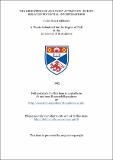The orienting of auditory attention: event-related potential investigations
Abstract
The P300 complex has been dissociated into a parietally maximal P3b and a more anteriorly distributed P3a in auditory, visual and somatosensory modalities. The seven experiments reported in this thesis investigate the variables affecting the elicitation of the P3a. The Knight et al. (1989) paradigm was used which involves the presentation of frequent, rare target and rare nontarget auditory stimuli. Experiment 1 showed that the P3a was elicited by novel sounds (environmental noises) when presented as rare nontargets in a sequence of frequent and target tones. When the rare nontarget novel sounds were presented in a sequence of other novel sounds the P3a was not elicited (Experiment 2). Experiment 3 showed that making the rare novel sound a target abolished the P3a, as did omitting the frequent stimuli from the sequence (Experiment 4). In the experiments in which the P3a was abolished, the novel sounds were found to elicit a P300 deflection with a parietally maximal scalp distribution (P3b). Other experiments showed no indication of habituation of the P3a over subsequent stimulus presentations (experiment 6) but did show that the amplitude of the P3a was larger when preceded by several stimuli different to the eliciting novel sound, than when immediately preceded by the identical sound (experiment 7). In contrast to novel sounds, tones did not elicit a P3a, even when presented as rare nontargets among frequent and target novel sounds (experiment 5). The findings were related to a recent model of auditory attention (Naatanen, 1990). The P3a was interpreted as reflecting a process related to the orienting of attention resulting from the detection of a mismatch between present and previous stimuli.
Type
Thesis, PhD Doctor of Philosophy
Collections
Items in the St Andrews Research Repository are protected by copyright, with all rights reserved, unless otherwise indicated.

